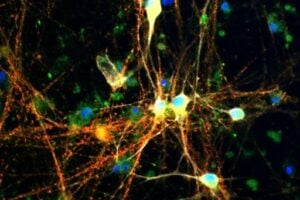About one in every five people carries a version of a gene that, although largely unsung, appears to confer protection against both Alzheimer’s disease and Parkinson’s disease, Stanford Medicine investigators and their colleagues have learned. These lucky people may someday benefit all the more from a vaccine that could slow or stall the progression of these two most common neurodegenerative conditions.
Risk Benefit Better Than 10% !
An analysis of medical and genetic data from hundreds of thousands of people of diverse ancestries from several continents has revealed that carrying this gene version, or allele, reduced people’s chances of contracting either Parkinson’s or Alzheimer’s by more than 10% on average.
The evidence suggests that a protein called tau, which is notorious for aggregating in the brains of Alzheimer’s patients, may also be involved, in some mysterious way, in the development of Parkinson’s disease.
The findings and implications are described in a paper published online Aug. 29 in the Proceedings of the National Academy of Sciences. Emmanuel Mignot, MD, PhD, the Craig Reynolds Professor in Sleep Medicine and a professor of psychiatry and behavioral sciences, shares senior authorship with Michael Greicius, MD, the Iqbal Farrukh and Asad Jamal Professor and a professor of neurology and neurological sciences, and Jean-Charles Lambert, PhD, director of research for Inserm at the University of Lille in France. Lead authors are Yann Le Guen, PhD, assistant director of computational biology in Stanford Medicine’s quantitative sciences unit; Guo Luo, PhD, an instructor of sleep medicine; former postdoctoral scholar Aditya Ambati, PhD; and Vincent Damotte, PhD, a bioinformatician associated with Lambert’s group.
Protective Allele DR4
The protective allele identified in the study is called DR4.
“In an earlier study we’d found that carrying the DR4 allele seemed to protect against Parkinson’s disease,” Mignot said. “Now, we’ve found a similar impact of DR4 on Alzheimer’s disease.”

The Stanford Medicine team combined dozens of medical and genetic databases collected from numerous countries — in Europe, East Asia, the Middle East, and South and North America. All told, the databases included more than 100,000 people with Alzheimer’s disease and more than 40,000 with Parkinson’s disease. The scientists contrasted the incidence and age of onset of Alzheimer’s and Parkinson’s among people with DR4 versus those without it and found a roughly 10% risk reduction in those carrying DR4.
“That this protective factor for Parkinson’s wound up having the same protective effect with respect to Alzheimer’s floored me,” Mignot said. “The night after we found that out, I couldn’t sleep.”
The investigators also analyzed data from the autopsied brains of more than 7,000 Alzheimer’s patients and found that DR4 carriers had fewer neurofibrillary tangles — long, filamentous aggregates, composed largely of tau, that characterize Alzheimer’s disease — as well as a later onset of symptoms, than their non-DR4 counterparts. The presence of neurofibrillary tangles has been shown to correlate strongly with the condition’s severity.
Carrying DR4 also correlated with a later onset of symptoms in Parkinson’s patients, even though neurofibrillary tangles aren’t typically seen in that disease.
This study hints that tau, an essential player in Alzheimer’s, may turn out to also play some kind of role in Parkinson’s, Mignot said, although what that role may be is not clear.
A cell’s surface is its display window
DR4 is one among copious alleles of a gene called DRB1, which itself is one among many in a large complex of genes — called the human lymphocyte antigen complex, or HLA — that’s crucial to rendering cells’ inner contents visible to the immune system.
A cell’s outer membrane keeps the cell’s insides in and its outsides out. But that’s not all it does. It also serves as a display window, exposing fragments of the proteins inside it to the immune system.
Routine exposure of these fragments, or peptides — stand-alone snippets of chopped-up proteins — on the cell’s surface (its outer membrane) allows roving immune cells to peruse them. By inspecting cell-surface peptides, these patrolling immune cells can see if there’s anything funny going on inside — namely, whether any foreign or altered protein might reside in the cell, implying an infection or cancerous state, respectively.
Facilitating this window shopping are specialized proteins that can grab onto and encase all these peptides and display them on cell surfaces in a way that’s optimal for immune recognition. These specialized proteins are the products of the HLA genes.
DR4 Offers “Protective Autoimmunity”
Each of the numerous HLA genes comes in a vast variety of alleles. Each of us inherits a different collection of these alleles. Because different HLA alleles’ protein products bind to different sets of peptides, the assortment of peptides shows how immune systems vary from one person to the next.
When the immune system spots a surface peptide it thinks it’s never seen before, it can mount a powerful attack on any cell displaying that peptide on its surface. Now and then, the judgment turns out to be a case of mistaken identity. Autoimmunity is such a phenomenon.
Mignot thinks DR4 is involved in what has been called “protective autoimmunity”: A certain peptide that DR4 knows how to grab onto and display is actually a chemically modified segment of a normal protein our cells make — tau. It’s the chemical modification that’s causing trouble.
The tau connection?
Noting DR4’s beneficial effects on tau levels and pathologies in both Alzheimer’s and Parkinson’s, the researchers zeroed in on tau. They chopped molecules of the protein into 482 peptides collectively spanning tau’s entire sequence, then placed them into separate dishes along with DR4’s protein product (also called DR4) to see if it binds strongly to any of those peptides.
In addition, the researchers tested all the biologically likely chemical modifications each of those peptides can accrue once it’s been produced inside a cell.
DR4 exerted an especially mighty grip on a single peptide. Called PHF6, this segment of the tau protein is frequently altered in the brains of Alzheimer’s patients by a change called acetylation — the affixation of a small chemical clump to one of the protein’s constituent building blocks on that segment. Acetylated PHF6 has already been implicated in tau molecules’ tendency to aggregate into neurofibrillary tangles.
“The only peptide DR4 bound to strongly was PHF6 — and then only when this peptide was acetylated,” Mignot said. It’s already known that PHF6 acetylation facilitates tau aggregation into neurofibrillary tangles, he noted.
The acetylation may “fool” the immune system into thinking PHF6 is a foreigner and a menace, Mignot said, leading the immune system to attack and demolish incipient neurofibrillary tangles.
Vaccine to Boost DR4
He thinks it may be possible to make DR4 work harder in those who carry it by creating a vaccine consisting of acetylated PHF6. In drawing the immune system’s attention to this modified peptide, such a vaccine might interfere with tau’s aggregation. In people who carry any of the protective variants of DR4 (not all of them are protective) and whose brains have begun to accumulate tau aggregates, a vaccine could delay onset or slow progression of Alzheimer’s and possibly Parkinson’s, Mignot suggested.
People who don’t carry DR4 wouldn’t benefit from this vaccine, Mignot noted. Furthermore, DR4 comes in a spectrum of subtypes, distinguished by minuscule differences in their genetic sequence. Of DR4’s six or seven most common subtypes, one may be more common among people of one ancestry, while others may be more dominant in people of other ancestries. The DR4 subtype most common among East Asians doesn’t seem to help as much in warding off either neurodegenerative disease as the DR4 subtypes most common in other populations do, for example.
A blood test ought to be given to see who should or shouldn’t get vaccinated, Mignot said.
Patent Application
Stanford University’s office of technology licensing has filed a patent application on intellectual property associated with the findings in this study.
Some 160 additional researchers from as many institutions in roughly 25 countries contributed to the work.
More Information
The study was funded by the National Institutes of Health (grants AG060747, AG066206 and AG066515), the European Union, the Michael J. Fox Foundation, the Alzheimer’s Association, the Iqbal Farrukh and Asad Jamal Fund, the European Alzheimer DNA BioBank, the Japan Agency for Medical Research and Development, the Einstein Center for Neurosciences in Berlin, the Swedish Research Council, the European Research Council, and the Swedish State Support for Clinical Research.
About Stanford Medicine
Stanford Medicine is an integrated academic health system comprising the Stanford School of Medicine and adult and pediatric health care delivery systems. Together, they harness the full potential of biomedicine through collaborative research, education and clinical care for patients. For more information, please visit med.stanford.edu.











